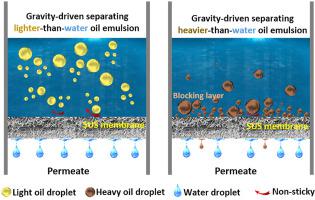当前位置:
X-MOL 学术
›
J. Membr. Sci.
›
论文详情
Our official English website, www.x-mol.net, welcomes your
feedback! (Note: you will need to create a separate account there.)
In situ silica growth for superhydrophilic-underwater superoleophobic Silica/PVA nanofibrous membrane for gravity-driven oil-in-water emulsion separation
Journal of Membrane Science ( IF 8.4 ) Pub Date : 2020-10-01 , DOI: 10.1016/j.memsci.2020.118476 Weihua Qing , Xianhui Li , Yifan Wu , Senlin Shao , Hao Guo , Zhikan Yao , Yiliang Chen , Wen Zhang , Chuyang Y. Tang
Journal of Membrane Science ( IF 8.4 ) Pub Date : 2020-10-01 , DOI: 10.1016/j.memsci.2020.118476 Weihua Qing , Xianhui Li , Yifan Wu , Senlin Shao , Hao Guo , Zhikan Yao , Yiliang Chen , Wen Zhang , Chuyang Y. Tang

|
Abstract Superhydrophilic-underwater superoleophobic (SUS) membranes have been demonstrated to be promising materials for oily wastewater treatment. However, development of facile, low cost and robust SUS membrane with high flux and less membrane fouling is still challenging. In this study, we reported a simple electrospinning/in-situ growth strategy to prepare SUS SiO2@PVA nanofibrous membrane for gravity-driven separation of oil/water mixture. In specific, a highly porous PVA nanofibrous membrane was first fabricated by electrospinning technique, followed by an in-situ growth of silica nanoparticles on the pristine PVA nanofibers through a modified Stober reaction. The abundant hydroxyl groups on PVA nanofibers enabled uniform and stable deposition of silica nanoparticles, thus simultaneously realizing high surface energy surface (hydrophilic nature of PVA and silica) and multi-scale roughness. As expected, the resultant membrane exhibited excellent in-air “water-loving” (instantaneous in-air water wetting) and underwater “oil-hating” properties (underwater oil contact angle of 161.8° and sliding angle of 6.2°). The SUS SiO2@PVA membranes exhibited efficient separation of both free oil/water mixture and a variety of surfactant-stabilized oil-in-water emulsions in a gravity-driven filtration process. In addition, oil density played an important role during the separation process, due to superior separation performance was achieved for lighter-than-water oil when compared to heavier-than-water oils. Moreover, the membrane showed robust reusability that it maintained stable oil rejection and permeate flux in cyclic experiments.
中文翻译:

超亲水-水下超疏油二氧化硅/PVA纳米纤维膜的原位二氧化硅生长,用于重力驱动的水包油乳液分离
摘要 超亲水-水下超疏油 (SUS) 膜已被证明是用于含油废水处理的有前途的材料。然而,开发具有高通量和较少膜污染的简便、低成本和坚固的 SUS 膜仍然具有挑战性。在这项研究中,我们报道了一种简单的静电纺丝/原位生长策略来制备用于重力驱动油/水混合物分离的 SUS SiO2@PVA 纳米纤维膜。具体而言,首先通过静电纺丝技术制造了高度多孔的 PVA 纳米纤维膜,然后通过改良的 Stober 反应在原始 PVA 纳米纤维上原位生长二氧化硅纳米粒子。PVA 纳米纤维上丰富的羟基使二氧化硅纳米粒子能够均匀稳定地沉积,从而同时实现高表面能表面(PVA 和二氧化硅的亲水性)和多尺度粗糙度。正如预期的那样,所得膜表现出优异的空气中“亲水性”(瞬间空气中水润湿)和水下“憎油性”特性(水下油接触角为 161.8°,滑动角为 6.2°)。SUS SiO2@PVA 膜在重力驱动的过滤过程中表现出对游离油/水混合物和各种表面活性剂稳定的水包油乳液的有效分离。此外,油密度在分离过程中也起着重要作用,因为与比水重的油相比,轻于水的油具有更好的分离性能。而且,
更新日期:2020-10-01
中文翻译:

超亲水-水下超疏油二氧化硅/PVA纳米纤维膜的原位二氧化硅生长,用于重力驱动的水包油乳液分离
摘要 超亲水-水下超疏油 (SUS) 膜已被证明是用于含油废水处理的有前途的材料。然而,开发具有高通量和较少膜污染的简便、低成本和坚固的 SUS 膜仍然具有挑战性。在这项研究中,我们报道了一种简单的静电纺丝/原位生长策略来制备用于重力驱动油/水混合物分离的 SUS SiO2@PVA 纳米纤维膜。具体而言,首先通过静电纺丝技术制造了高度多孔的 PVA 纳米纤维膜,然后通过改良的 Stober 反应在原始 PVA 纳米纤维上原位生长二氧化硅纳米粒子。PVA 纳米纤维上丰富的羟基使二氧化硅纳米粒子能够均匀稳定地沉积,从而同时实现高表面能表面(PVA 和二氧化硅的亲水性)和多尺度粗糙度。正如预期的那样,所得膜表现出优异的空气中“亲水性”(瞬间空气中水润湿)和水下“憎油性”特性(水下油接触角为 161.8°,滑动角为 6.2°)。SUS SiO2@PVA 膜在重力驱动的过滤过程中表现出对游离油/水混合物和各种表面活性剂稳定的水包油乳液的有效分离。此外,油密度在分离过程中也起着重要作用,因为与比水重的油相比,轻于水的油具有更好的分离性能。而且,











































 京公网安备 11010802027423号
京公网安备 11010802027423号